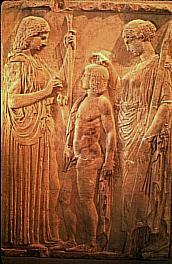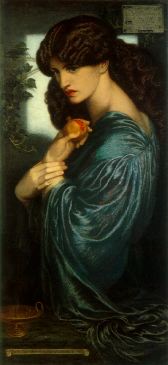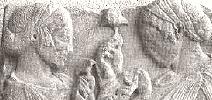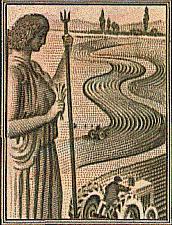DHMHTHR
(Demeter)
Goddess of the Harvest
|
Roman Name: Ceres |
Images of Demeter and the rest of the divine family are available courtesy of Laurel Bowman's Classical Myth: The Ancient Sources
Note: Links on this page will open a new window on your browser.
For those who subscribe to the controversial idea of a prehistoric Great Goddess and think of her in terms of a "great mother," perhaps it is Demeter's nature that least deviates from that form. The name -meter, in fact, almost certainly is a form of the word "mother." Demeter, much more closely than her Olympian counterparts Hera or Athene or Aphrodite, is associated with chthonic power. In their chapter on the Great Goddess theory Harris and Platzner define chthonic as the "death-wielding aspect," (153) but that isn't quite an accurate translation. Chthonic deities were those whose powers came from the earth, that's all. Demeter's brother Hades is also a chthonic deity, but as much for his association with wealth buried in the earth as for his role as lord of the dead. More on that next week.
As Aphrodite was the goddess of sexuality and animal fertility, Demeter was the goddess of vegetable fertility. Thus, her Roman name, Ceres, is the root of the English word "cereal," which referred to grains in general before the age of Kellogg's Corn Flakes.
 And speaking of
corn, when Demeter is referred to as "the goddess of corn" this is not a
reference to maize (the vegetable that Americans call "corn"), but rather to wheat.
That's because the early mythographers in the English language were British, and in
Britain the term refers to cereal (in the pre-Kelloggian sense) grain.
And speaking of
corn, when Demeter is referred to as "the goddess of corn" this is not a
reference to maize (the vegetable that Americans call "corn"), but rather to wheat.
That's because the early mythographers in the English language were British, and in
Britain the term refers to cereal (in the pre-Kelloggian sense) grain.
 In ancient
depictions of her you will almost always see her carrying a sheaf of wheat, and never
an ear of corn. If you'll think back to your days in grade school, you'll remember
that maize is a New World crop that the Indians introduced to the Pilgrims.
In ancient
depictions of her you will almost always see her carrying a sheaf of wheat, and never
an ear of corn. If you'll think back to your days in grade school, you'll remember
that maize is a New World crop that the Indians introduced to the Pilgrims.
Okay, now we've got that cleared up, let's look at Demeter's history.
Unlike the contradictory stories about some mythological figures such as Hephaestus (when was he born, and did he have a father or not?) or Aphrodite (whom some authors claim as the oldest of the goddesses and others claim as the daughter of Zeus and either Dione or Metis--yes, Metis, Athene's mom), Demeter's biography is straightforward. She is one of the senior generation of the Olympian pantheon, along with her sisters Hera and Hestia and her brothers Zeus, Poseidon, and Hades. They are all the children of the ill-fated Cronus and the earth goddess Rhea.
I know you're aware of who Cronus and Rhea are already, but please click on these links anyway because there's some additional information there that hasn't come up yet. "Cronus," as mentioned in class, is a Latinized transcription of the Greek name Kronos, or KRONOS.
You'll notice that the Cronus link ends with an interesting indication that it is Cronus who is associated with the harvest aspect, as opposed to the fertility aspect. Rhea produces; Cronus reaps:
In Athens on the 12th day of the month Hekatombaion a festival was held in honour of Cronus, which was known as the "Kronia." It was a celebration of the harvest. In art, Cronus was depicted carrying a sickle used to gather the harvest, but this was also the weapon he used to castrate his father.I'll resist any temptation to make a bad pun here about reaping what you sow, given the fact the same thing eventually happened to Cronus.
I included the Rhea link because I think the part about the lion chariot is pretty cool. You can see this chariot in action in this detail from a frieze that was found in the Siphnians' treasury at Delphi, a sacred site where many Greek cities kept caches of treasure on hand to appease the gods. The lion is also associated with Cybele, or Kybele (who, in turn, is often associated with Rhea, and who figures heavily in the writings of Great Goddess theorists). According to one version of the myth of Atalanta and Hippomenes, a pair of human lovers whom we will study when it's Aphrodite's turn as Deity of the Week, these two frisky mortals got turned into lions on account of their sexual shenanigans in Cybele's temple precincts.

Demeter combines elements of both her parents, as she is the goddess of fertility and harvest all in one. Her first worshipper was Triptolemus, a native of Eleusis (an outlying deme--which is sort of like a county--belonging to Athens) to whom Demeter gave the secret of cultivating grain. She also gave him a magic chariot so he could travel around and spread the news, sowing crops as he went. Think of him as a mythological precursor to our American folk hero Johnny Appleseed. In some versions of the Demeter story, Triptolemus is substituted for Demophoön, the child of Metaneira whom Demeter nursed and toasted over the fire to make him immortal. Obviously, if that is the case then that aspect of the story turns out rather differently from the version in the Homeric Hymn to Demeter.
The photograph shown here is of an ancient relief that was found at Eleusis, representing Demeter and her daughter Persephone (Roman name Proserpina) presenting Triptolemus with his first set of seeds. Note the similarity of the goddesses' poses to the photo on page 155 of our textbook, which does not include Triptolemus. The image in the top right-hand corner of this page is taken from a Greek postage stamp; if you scroll up and take another look at it, you'll see that it is clearly based on the Eleusis relief, only Triptolemus's chariot appears to have metamorphosed into a tractor.
 Persephone and Eleusis are Demeter's two most famous associations. The so-called "Rape of Persephone" is described in
such gorgeous detail in the Homeric Hymn to Demeter that I
hardly need to go into any detail about it here. But I would like to
mention that this is another one of those tricky words that have changed meaning; "rape"
here means "abduction," though obviously the modern meaning underlies it in this case.
Persephone and Eleusis are Demeter's two most famous associations. The so-called "Rape of Persephone" is described in
such gorgeous detail in the Homeric Hymn to Demeter that I
hardly need to go into any detail about it here. But I would like to
mention that this is another one of those tricky words that have changed meaning; "rape"
here means "abduction," though obviously the modern meaning underlies it in this case.
For some reason the Rape of Persephone is a favorite subject for artists over the past couple of centuries, and it's a common theme in statues and paintings. One of my favorite images, however, is this painting on the right by the British Victorian artist Dante Gabriel Rossetti, which shows Persephone all by herself, clutching the fatal pomegranate and looking suitably depressed.
In your textbook you can find a really creepy modern interpretation on one of the color plates and a moving poem, "The Pomegranate," in which a mother finds personal meaning in the Persephone story: see your syllabus for page numbers.
While the best in-depth account of the story is unquestionably the Homeric Hymn to Demeter, Ovid's retelling of the myth in his Metamorphoses runs a close second. The story has been reworked several times since then. The most recent version I've heard of is an episode of the television series Hercules: The Legendary Journeys. Not as thought-provoking as those two artistic and poetic reinterpretations in your textbook, and a serious stretch of the mythology so the writers could include the titular legendary hero, but great fun all the same.
Persephone is sometimes called Kore, which simply means "the maiden." The word has two syllables; it's pronounced "KOR-ay."
Demeter's major temple was at Triptolemus's home town of Eleusis, in Attica--the area in which Athens is located. Click here for an interactive map; click on an area of the image to bring up associated photographs of the site and museum.
The most important of Greek ritual festivals, the Eleusinian Mysteries, were held in the month of Boedromion (roughly equivalent to late September/early October). Although primarily celebrated by the citizens of nearby Athens, initiation was open to foreigners as well and a universal peace was declared during the festival period, similar to the peace that was declared when the great athletic competitions were held at Olympia.
Initiates were sworn to strict secrecy about what took place at the actual enactment of the Mysteries, and this vow was kept so well that today we know very little about it from textual evidence other than the fact that one of the high points seemed to be the formal unveiling of an ear of wheat or some other grain. Archaeologists have suggested the possibility of an ingenious system for piping hot air under the seats of the Telesterion, though the physical evidence for such a trick is sketchy at best. Still, this subtle "hot seat" effect would no doubt have added to the sense that something supernatural was going on.
 |
Revelation or desecration of the Mysteries was an offense punishable by death, as one can see in ancient court records. The Athenian aristocrat Andocides, accused in 399 B.C. of violating a prohibition against participation in the Mysteries on account of an impious act several years before, served as his own defendant when he was put on trial. His speech, On the Mysteries, is considered the finest of the several speeches he had to make in his own defense (evidently Andocides was something of a magnet for trouble). It's a long speech and you aren't expected to read the whole thing, but do scan it: it's amazing, isn't it, that we can still read word-for-word legal speeches that were delivered in Athenian courts 2400 years ago? We even have a speech by the prosecution, the orator Lysias, that lays out the case against him!
 Another important festival was the Thesmophoria, a festival celebrated exclusively by women. Again,
the sacred enactments were carried on in secret and we don't know much about them
other than the fact that the putrefied bodies of sacrified piglets were uncovered, having been
buried in the ground some weeks before, and mixed with grain or wheat cakes in some sort of
fertility ritual.
Another important festival was the Thesmophoria, a festival celebrated exclusively by women. Again,
the sacred enactments were carried on in secret and we don't know much about them
other than the fact that the putrefied bodies of sacrified piglets were uncovered, having been
buried in the ground some weeks before, and mixed with grain or wheat cakes in some sort of
fertility ritual.
Aristophanes' comedy Thesmophoriazusae (Women at the Thesmophoria, composed in the fifth century B.C.E.) makes fun of his contemporary Euripides' portrayals of women by having the tragedian deck himself out in drag in order to attend the Thesmophoria festival and defend himself, since he knows the women intend to gather there and pass judgment on him for what Aristophanes describes as his unflattering exposure of all women's follies. This is widely considered ironic today since Euripides is generally acknowledged as the most feminist of Greek playwrights, and Aristophanes as rather reactionary in his political and social views...which perhaps is why he saw these portrayals as unflattering! A conservative Athenian woman would never have dreamed of behaving like an assertive Euripidean heroine. Some scholars have tried to guess at what happened at the Thesmophoria from looking at the events in Aristophanes' play, but that's probably a hopeless task. After all, being a man, Aristophanes himself probably didn't know either!
Some other Demeter cults are described by the ancient travel writer Pausanias in his Description of Greece.
